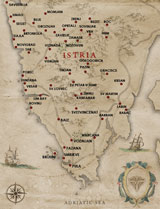The notable non Istrians are individuals who are not Istrian by birth or have not lived most of their lifes in Istria but
who have been or are in some direct or significant way connected with Istria in their professional or social role:
WRITERS, HISTORIOGRAPHERS AND ARCHAEOLOGISTS
- Dario ALBERI (author of the book: “Istria – storia, arte, cultura”, born in Trieste,
in Italy, in 1930)
- Dante ALIGHIERI (Italian poet who wrote La Divina Commedia, The Divine Comedy, born in Florence, in Italy,
in 1256. Dante Aleghieri visited Istria and in his art work he mentioned Pula)
- Richard Francis Burton (British consul and explorer born in Hertfordshire, in UK, in 1821. Richard Burton wrote about
Istrian prehistoric hillfort settlements and about the seaboard of Istria)
- Giacomo Girolamo CASANOVA (spy, diplomat, writer and adventurer born in Venice, in Italy, in 1724. Visited
Istria several times and in his memories he wrote about Vrsar)
- Anton GNIRS (historiographer born in Zatec, in the Czech Republic, in 1873; Anton Gnirs did many studies
of various Istrian monuments)
- Drazan GUNJACA (Roman writer and lawyer born in Sinj, in Croatia, in 1958)
- Thomas Graham JACKSON (architect, antiquarian, traveller and writer. In 1887 he wrote a three-volume
book Dalmatia, the Quarnero and Istria with Cetinje in Montenegro and the Island of Grado; he was born in London, in the UK,
in 1835)
- James JOYCE (writer, educator and critic born in Rarhgar, a suburb of Dublin, in Irland, in 1882. James
and Nora Joyce lived in Pula for four months but did not like the town probably due to the very cold winter 1904-1905, referred
to it as a “naval Siberia”)
- Pietro KANDLER (historiographer born in Trieste, in Italy, in 1804. Pietro Kandler published many articles
about Istria that became significant sources on Istrian history)
- Claudio MAGRIS (journalist and critic born in Trieste, in Italy, in 1939)
- Vladimir NAZOR (writer, translator and polititians born in Zagreb in 1876. He wrote the tale Veli
Joze. Veli Joze features a helpful and good-natured giant living in the area around Motovun, located in the inner Istria. During World War II, Nazor joined Tito's Partisans and after
the war, he became the first president of the People's Republic of Croatia's Parliament in Federal Peple's Republic of Yugoslavia)
- Johann Weichard Freiherr VON VALVASOR (historiographer, geographer, ethnographer, cartographer, scientist,
collector, soldier, painter and publisher born in Ljubljana, at that time named Laybach, in Slovenia, in 1641. In 1681 he
published Carniolia, Karstia, Histria et Windorum Marchia where Valvasor writes also about Istria. This work offers a universal
17th century description of a large part of what is today Slovenia and also includes parts on Istria)
- Dragan VELIKIC (writer born in Belgrade, in Serbia, in 1953. Dragan Velikic grown up in Pula and in his
Roman Via Pola was inspired by Pula)
- Jules Gabriel VERNE (writer born in Loire Atlantique, Pays-de-la-Loire, in France, in 1828. Mathias Sandorf
novel is partially set in Trieste, Istria (Pazin) and Dalmatia)
- Sextil PUSCARIU (filolog was born in Braşov, in Romania, in 1877. Sextil Puşcariu published in Bucureşti
in 1926 the book “Studii istroromâne” about istro-romanian language)
ARCHITECTS
- Andrea PALLADIO (Renaissance architect born in Padua, in Italy, in 1508. Andrea Palladio, like Michelangelo
Buonarotti and several other Renaissance architects, came to Pula to re-discover the art of building of the old Romans)
- Carl SEIDL (architect born in Superk, in Moravska in 1858; he was among the most important architects
in the Austro-Hungarian Monarchy and he designed in Istria some of the most beautiful villas in Lovran and Opatija such as:
Frappart, Magnolia, Blankenstein, Rosenvilla, Santa Maria, Nizza, Count Brunitzky, Edera, Ariston, Tomasic, and several other
interesting public buildings)
- Natale TOMMASI (architect, born in Cagnola near Trento, in Italy in 1853; he was the architect of the
Naval Church in Pula, of the current Pula’s Muesum building and of the Parish Church of St. Agnese in Medulin; he also
contributed to the conservation of the most important Roman monuments in Pula and he also worked on the conservation of the
Basilica in Porec)
ARTIST
- Michelangelo BUONARROTI (Renaissance artist, one of the finest sculptors and artists of all time also
well known for his painting of the Sistine Chapel ceiling in Vatican, born in Caprese, in Tuscany, in Italy. Michelangelo
Buonarotti maybe visited Pula to study Roman monuments and his drawing (or Sangallo drawing) of the Triumphal Arch of the
Sergi is kept in a museum in France)









